COMSOL
Multiphysics ™
M
n
i
i
c
o
u
r
s
e
V E R S I O N 3 . 3
�
How to contact COMSOL:
Benelux
COMSOL BV
Röntgenlaan 19
2719 DX Zoetermeer
The Netherlands
Phone: +31 (0) 79 363 4230
Fax: +31 (0) 79 361 4212
info@femlab.nl
www.femlab.nl
Denmark
COMSOL A/S
Diplomvej 376
2800 Kgs. Lyngby
Phone: +45 88 70 82 00
Fax: +45 88 70 80 90
info@comsol.dk
www.comsol.dk
Finland
COMSOL OY
Lauttasaarentie 52
FIN-00200 Helsinki
Phone: +358 9 2510 400
Fax: +358 9 2510 4010
info@comsol.fi
www.comsol.fi
France
COMSOL France
WTC, 5 pl. Robert Schuman
F-38000 Grenoble
Phone: +33 (0)4 76 46 49 01
Fax: +33 (0)4 76 46 07 42
info@comsol.fr
www.comsol.fr
Germany
FEMLAB GmbH
Berliner Str. 4
D-37073 Göttingen
Phone: +49-551-99721-0
Fax: +49-551-99721-29
info@femlab.de
www.femlab.de
Italy
COMSOL S.r.l.
Via Vittorio Emanuele II, 22
25122 Brescia
Phone: +39-030-3793800
Fax: +39-030-3793899
info.it@comsol.com
www.it.comsol.com
Norway
COMSOL AS
Søndre gate 7
NO-7485 Trondheim
Phone: +47 73 84 24 00
Fax: +47 73 84 24 01
info@comsol.no
www.comsol.no
Sweden
COMSOL AB
Tegnérgatan 23
SE-111 40 Stockholm
Phone: +46 8 412 95 00
Fax: +46 8 412 95 10
info@comsol.se
www.comsol.se
Switzerland
FEMLAB GmbH
Technoparkstrasse 1
CH-8005 Zürich
Phone: +41 (0)44 445 2140
Fax: +41 (0)44 445 2141
info@femlab.ch
www.femlab.ch
United Kingdom
COMSOL Ltd.
Studio G8 Shepherds Building
Rockley Road
London W14 0DA
Phone:+44-(0)-20 7348 9000
Fax: +44-(0)-20 7348 9020
info.uk@comsol.com
www.uk.comsol.com
United States
COMSOL, Inc.
1 New England Executive Park
Suite 350
Burlington, MA 01803
Phone: +1-781-273-3322
Fax: +1-781-273-6603
COMSOL, Inc.
1100 Glendon Avenue, 17th Floor
Los Angeles, CA 90024
Phone: +1-310-689-7250
Fax: +1-310-689-7527
COMSOL, Inc.
744 Cowper Street
Palo Alto, CA 94301
Phone: +1-650-324-9935
Fax: +1-650-324-9936
info@comsol.com
www.comsol.com
For a complete list of international
representatives, visit
www.comsol.com/contact
Company home page
www.comsol.com
COMSOL user forums
www.comsol.com/support/forums
COMSOL Multiphysics Minicourse
© COPYRIGHT 1994–2006 by COMSOL AB. All rights reserved
Patent pending
The software described in this document is furnished under a license agreement. The software may be used
or copied only under the terms of the license agreement. No part of this manual may be photocopied or
reproduced in any form without prior written consent from COMSOL AB.
COMSOL, COMSOL Multiphysics, and COMSOL Script are trademarks of COMSOL AB.
Other product or brand names are trademarks or registered trademarks of their respective holders.
Version:
COMSOL 3.3
Sept. 2006
�
C O N T E N T S
Introduction
2
3
A Multiphysics Model
Background . . . . . . . . . . . . . . . . . . . . . . . . . 4
The Steady Conduction-Current Problem . . . . . . . . . . . . . 5
The Heat Transfer Problem . . . . . . . . . . . . . . . . . . . 6
Getting Started . . . . . . . . . . . . . . . . . . . . . . . 7
Geometry Modeling. . . . . . . . . . . . . . . . . . . . . . 9
Material Settings for Conductive Media DC . . . . . . . . . . . . . 10
Boundary Settings for Conductive Media DC . . . . . . . . . . . . 12
Solving the Conductive Media DC Problem . . . . . . . . . . . . . 15
Visualization and Postprocessing . . . . . . . . . . . . . . . . . 15
Mesh Generation. . . . . . . . . . . . . . . . . . . . . . . 18
Solver Parameters . . . . . . . . . . . . . . . . . . . . . . 20
Adding Heat Transfer to the Model . . . . . . . . . . . . . . . . 21
Material Settings for Heat Transfer . . . . . . . . . . . . . . . . 22
Boundary Settings for Heat Transfer . . . . . . . . . . . . . . . 25
Solving the Coupled Problem . . . . . . . . . . . . . . . . . . 26
Visualization and Postprocessing . . . . . . . . . . . . . . . . . 26
Strong Coupling; Temperature-Dependent Material Properties . . . . . 27
Solving the Strongly Coupled Problem . . . . . . . . . . . . . . . 28
Visualization and Postprocessing . . . . . . . . . . . . . . . . . 29
Transient Multiphysics Simulation . . . . . . . . . . . . . . . . . 31
Initial Conditions . . . . . . . . . . . . . . . . . . . . . . . 31
Solver Parameters . . . . . . . . . . . . . . . . . . . . . . 32
Visualization and Postprocessing . . . . . . . . . . . . . . . . . 33
Extra Exercise: Capturing the Stiff Behavior . . . . . . . . . . . . . 36
Extra Exercise: Logical Expressions and Volume Integration . . . . . . . 38
Appendix A:
Using the Built-In CAD Tools
40
Appendix B: The Equations
48
The Conductive Media DC Equation . . . . . . . . . . . . . . . 48
The Heat Transfer Equation . . . . . . . . . . . . . . . . . . . 49
C O N T E N T S | i
�
The Bidirectionally Coupled Problem . . . . . . . . . . . . . . . 50
ii | C O N T E N T S
�
C O M S O L M u l t i p h y s i c s M i n i c o u r s e
C O M S O L M U L T I P H Y S I C S M I N I C O U R S E | 1
�
Introduction
COMSOL Multiphysics offers a complete environment that allows you to perform all
the steps in the modeling process. Its graphical user interface includes functions for
CAD modeling, the import of drawings and images, definition of material properties
and equations, mesh generation, solving the problem, visualization and
postprocessing.
Analyses in engineering design do not end with the computation of voltages, stresses,
and velocity fields. Frequently you must perform extensive postprocessing on the
computed output in order to arrive at useful engineering parameters such as
impedance, quality factor, conversion factors, or rotation angles. During the examples
in this minicourse you will quantify simulation results into hard engineering design
numbers.
The following introductory model gives an overview of basic modeling techniques and
introduces the concepts of multiphysics in the 2-way coupling of heat transport and
conduction currents. The model was inspired by simulations conducted by COMSOL
Multiphysics customers within the areas of MEMS and electronics, but the concepts
apply to all types of COMSOL Multiphysics models, whether from chemical
engineering, structural mechanics, electromagnetics, or any other field.
Enjoy your modeling!
The COMSOL Team
2 | C O M S O L M U L T I P H Y S I C S M I N I C O U R S E
�
A Multiphysics Model
This section shows you how to define and solve a first model in COMSOL
Multiphysics. The simulated phenomena are steady conduction currents and heat
generation in an aluminum film deposited on a silicon substrate. The model
investigates the temperature in the device after the current is applied.
The model exemplifies several steps that can be important in the modeling process. It
also gives a quick overview of the features available for modeling in COMSOL
Multiphysics’ graphical user interface. This example addresses the following important
COMSOL Multiphysics features:
• The use of predefined physics
The definition and solution of a multiphysics problem
Defining physical properties that depend on the solution itself
The definition and solution of a strongly coupled and transient multiphysics
problem
The extraction of design numbers using the postprocessing tools
The typical modeling steps include:
1 Definition of the geometry
2 Definition of the physics in the volume and at the boundaries
3 Meshing
4 Solving
5 Visualization
6 Postprocessing
C O M S O L M U L T I P H Y S I C S M I N I C O U R S E | 3
�
Background
A film of aluminum is deposited on a silicon substrate. The aluminum is approximately
0.1 mm thick with the pattern shown in the following picture.
Aluminum deposit
Input current
Ground
Silicon substrate
Figure 1: Device layout
The device’s width is roughly 2.4 mm, with a hole in the center with a diameter of
approximately 0.45 mm. A constant current passes through the deposit starting at t=0.
You wish to study the temperature distribution in the aluminum pattern as a function
of time. You also want to evaluate the electrical power distribution as well as the total
resistance over time.
The problem couples two physical phenomena, a current balance and a heat balance.
The electrical resistance increases with temperature, while the current density itself
serves as a heat source through ohmic losses in the current conduction. This implies
that the coupling between the two physics is a 2-way coupling. You cannot solve one
problem separate from the other.
4 | C O M S O L M U L T I P H Y S I C S M I N I C O U R S E
�
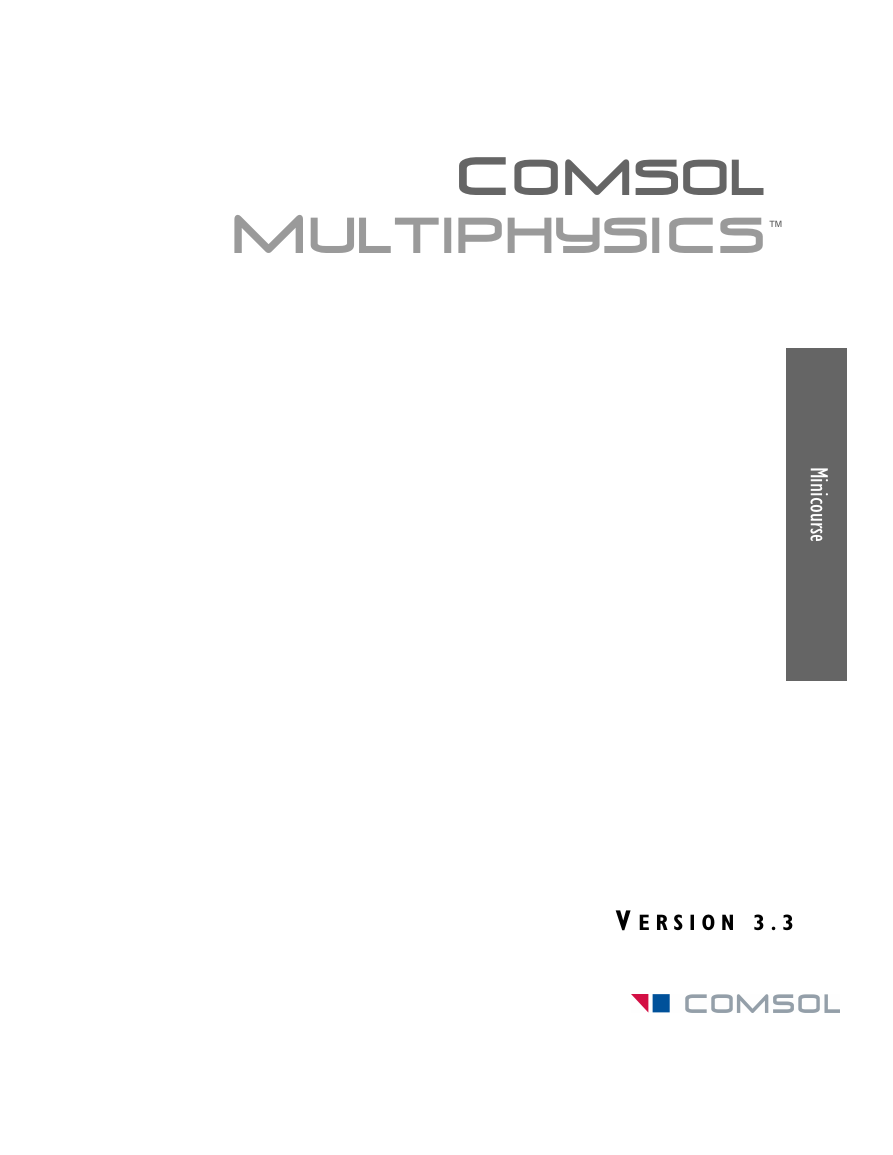
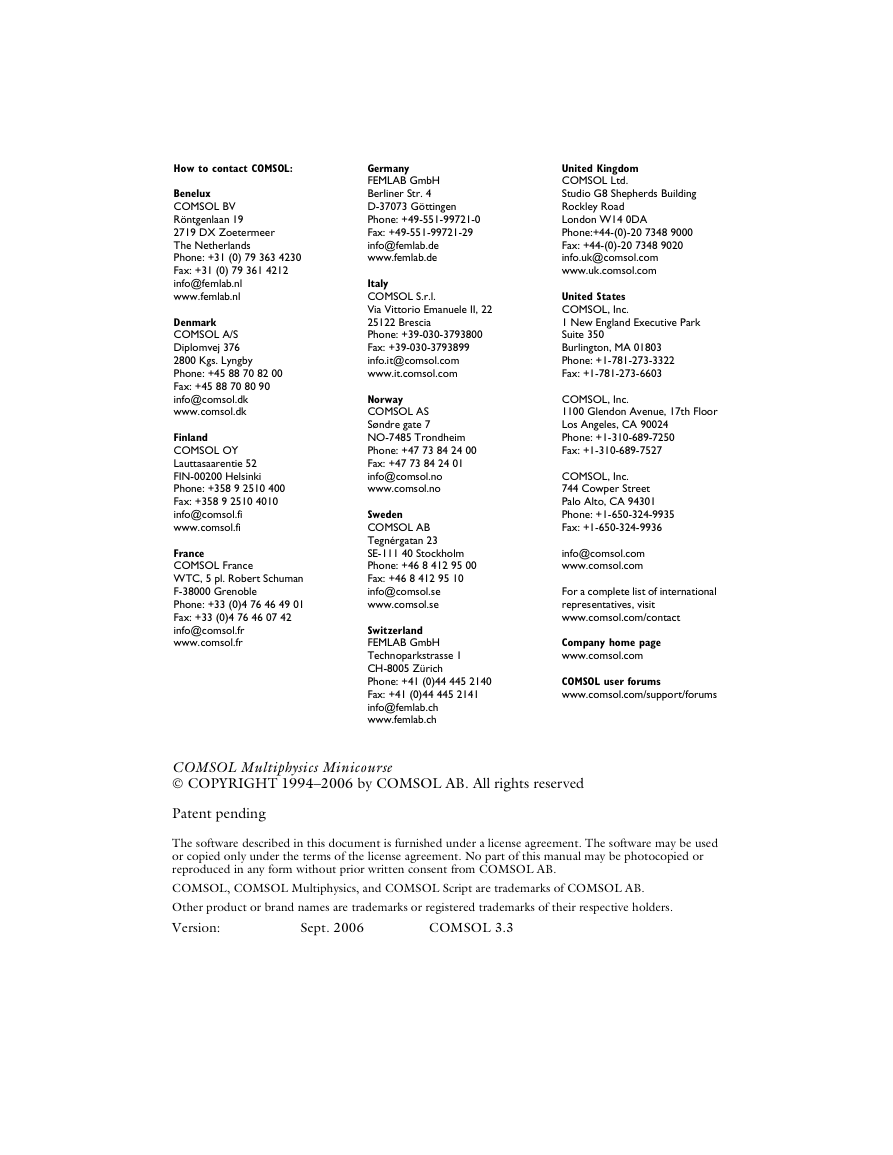


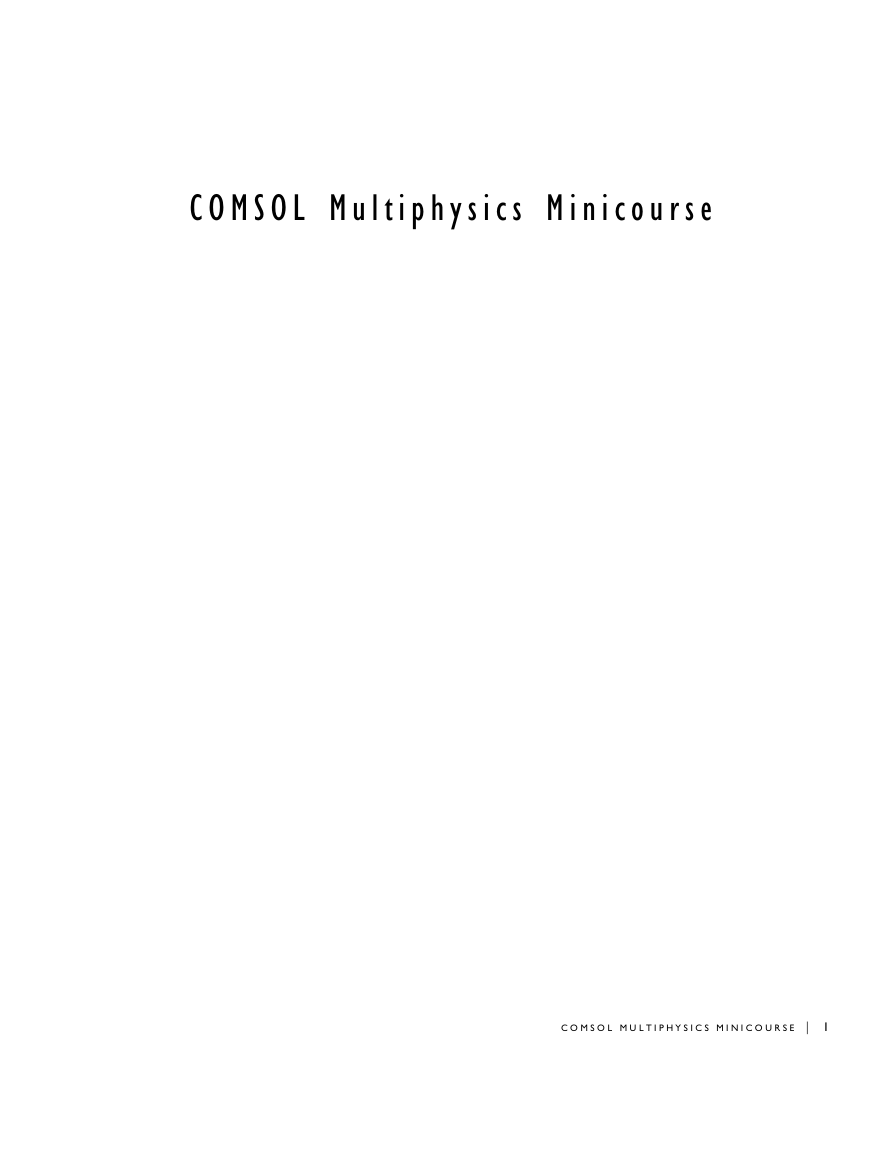
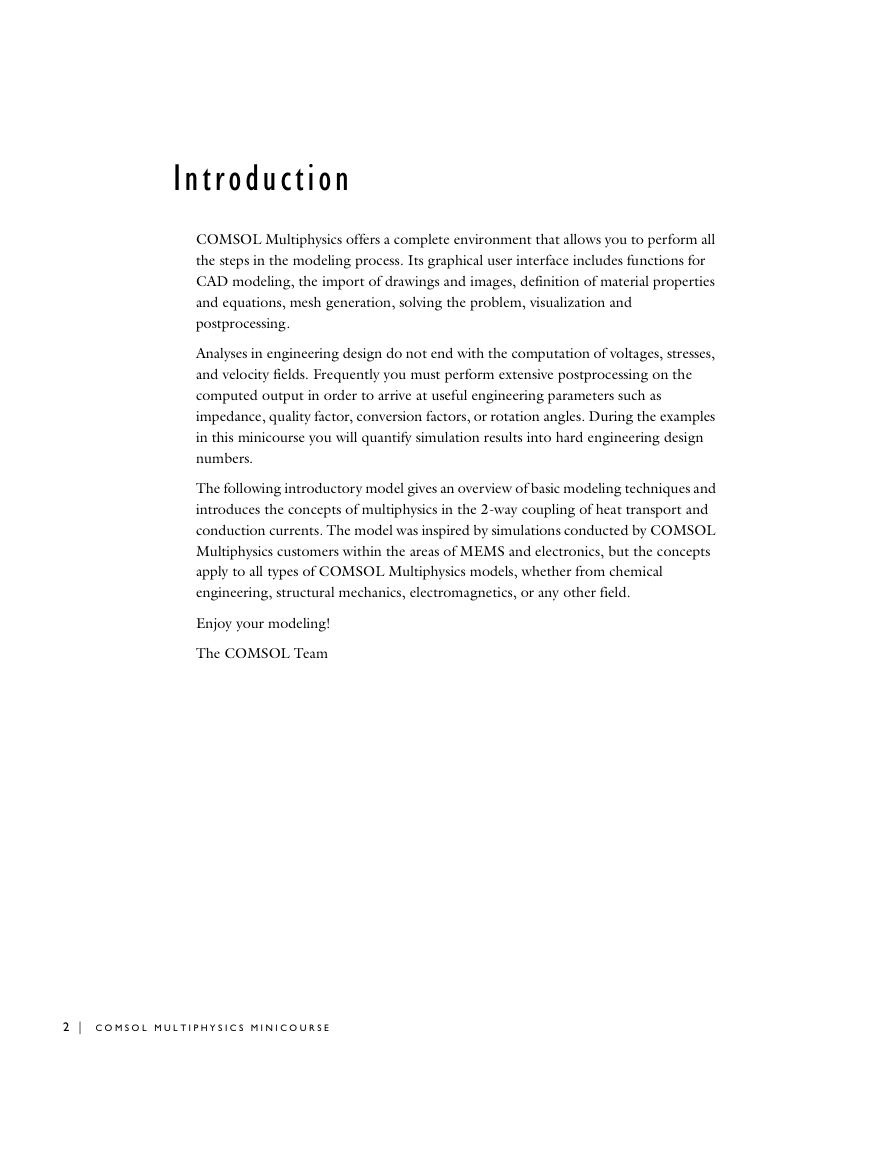
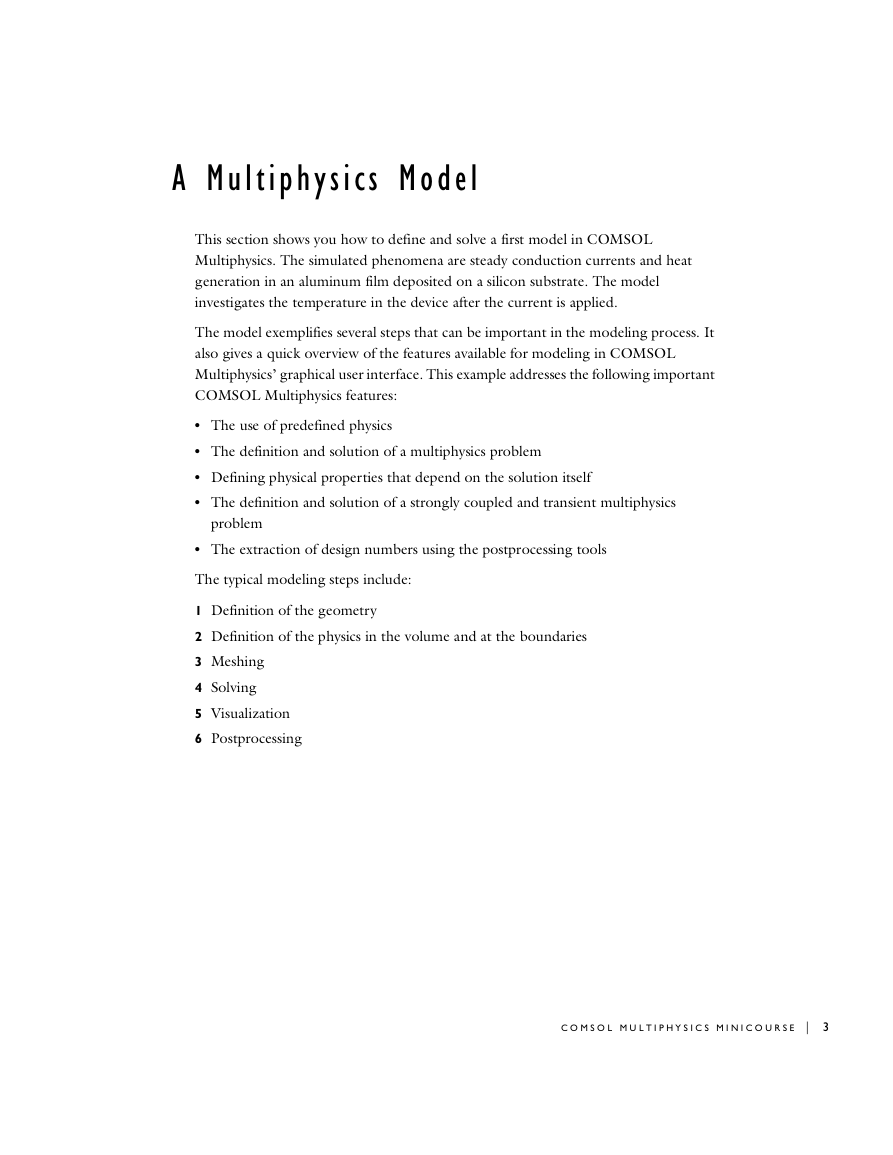









 2023年江西萍乡中考道德与法治真题及答案.doc
2023年江西萍乡中考道德与法治真题及答案.doc 2012年重庆南川中考生物真题及答案.doc
2012年重庆南川中考生物真题及答案.doc 2013年江西师范大学地理学综合及文艺理论基础考研真题.doc
2013年江西师范大学地理学综合及文艺理论基础考研真题.doc 2020年四川甘孜小升初语文真题及答案I卷.doc
2020年四川甘孜小升初语文真题及答案I卷.doc 2020年注册岩土工程师专业基础考试真题及答案.doc
2020年注册岩土工程师专业基础考试真题及答案.doc 2023-2024学年福建省厦门市九年级上学期数学月考试题及答案.doc
2023-2024学年福建省厦门市九年级上学期数学月考试题及答案.doc 2021-2022学年辽宁省沈阳市大东区九年级上学期语文期末试题及答案.doc
2021-2022学年辽宁省沈阳市大东区九年级上学期语文期末试题及答案.doc 2022-2023学年北京东城区初三第一学期物理期末试卷及答案.doc
2022-2023学年北京东城区初三第一学期物理期末试卷及答案.doc 2018上半年江西教师资格初中地理学科知识与教学能力真题及答案.doc
2018上半年江西教师资格初中地理学科知识与教学能力真题及答案.doc 2012年河北国家公务员申论考试真题及答案-省级.doc
2012年河北国家公务员申论考试真题及答案-省级.doc 2020-2021学年江苏省扬州市江都区邵樊片九年级上学期数学第一次质量检测试题及答案.doc
2020-2021学年江苏省扬州市江都区邵樊片九年级上学期数学第一次质量检测试题及答案.doc 2022下半年黑龙江教师资格证中学综合素质真题及答案.doc
2022下半年黑龙江教师资格证中学综合素质真题及答案.doc